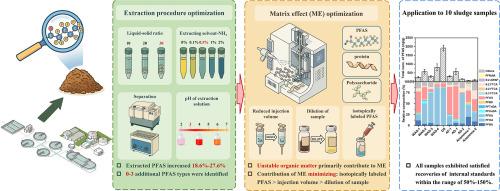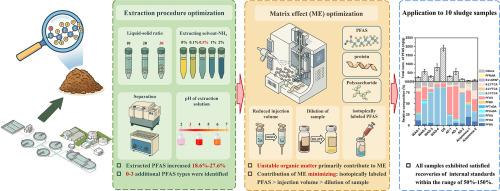污泥中PFAS定量分析的增强全过程方法:稳健提取和基质效应最小化方法
IF 12.4
1区 环境科学与生态学
Q1 ENGINEERING, ENVIRONMENTAL
引用次数: 0
摘要
准确定量复杂基质(如污水污泥)中的全氟烷基和多氟烷基物质(PFAS)是一项持续的挑战。为了解决这一问题,开发了一种经过严格验证的、可靠的、高效的方法,用于从污泥中提取大范围的PFAS(48种不同的物种)。通过优化固相萃取前的液固比(30 mL/g)、萃取溶剂(甲醇-氨水(99.5:0.5,v/v))、振荡时间(60 min, 300 rpm)和萃取液pH (pH = 3),可获得大部分目标PFAS(45 / 48)的可接受回收率(50% ~ 125%),相对标准偏差(≤16.84%)较低。与目前广泛使用的提取方法(如中国标准ASTM D2216 (HJ 1334-2023)和美国EPA方法1633A)相比,该方法可将提取的PFAS总浓度提高17.3%-27.6%,用于目标分析。此外,它还可以识别另外3种PFAS类型,从而提高PFAS分析的范围和准确性。在基质效应的研究中,尽管厌氧消化污泥的有机物含量(71.8%)高于废活性污泥(46.3%),但在PFAS提取和检测过程中,厌氧消化污泥的基质效应明显较低。这一结果表明,污泥中不稳定的有机物质可能是观察到的基质效应的主要原因。此外,在质谱分析过程中减少进样量,在检测前稀释样品,以及应用内标校正可以有效地减轻基质效应。将该方法应用于不同污泥样品的分析(n = 10),除污泥样品中的长链13C2-PFDoA外,所有样品的内标回收率均在50%-150%范围内。长链PFAS,如PFOA和PFOS,仍然是不同污泥中的主要化合物。这些发现突出了该方法对复杂矩阵的可靠性及其在更广泛的环境监测方面的潜力。本文章由计算机程序翻译,如有差异,请以英文原文为准。


Enhanced full-process method for the quantitative analysis of PFAS in sludge: Robust extraction and matrix effect-minimized method
Accurate quantification of per- and polyfluoroalkyl substances (PFAS) in complex matrices, such as sewage sludge, is an ongoing challenge. To address this issue, a rigorously validated, robust, and efficient method for a wide range of PFAS (48 different species) extraction in sludge was developed. By optimizing liquid-solid ratio (30 mL/g), extracting solvent (methanol ammonia hydroxide (99.5 : 0.5, v/v)), oscillation time (60 min, 300 rpm), and pH of extraction solution (pH = 3) before solid phase extraction, an acceptable recovery (50 %-125 %) of the majority target PFAS (45 of 48) with low relative standard deviation (≤ 16.84 %) was achieved. Compared to currently widely used extraction methods, such as ASTM D2216, a Chinese standard (HJ 1334–2023) and the U.S. EPA method 1633A, the proposed method achieves a 17.3 %-27.6 % increase in the extracted total PFAS concentration for target analysis. Furthermore, it enables the identification of 3 additional PFAS types, thereby enhancing the scope and accuracy of PFAS analysis. During the investigation of matrix effects, despite the higher organic matter content in anaerobically digested sludge (71.8 %) compared to waste activated sludge (46.3 %), the matrix effect in the former was significantly lower during PFAS extraction and detection. This result suggests that unstable organic matter in sludge may primarily contribute to the observed matrix effects. Furthermore, reducing the injection volume during mass spectrometry analysis, diluting samples prior to detection, and applying internal standards correction can effectively mitigate matrix effects. When this method was applied to the analysis of different sludge samples (n = 10), all samples exhibited satisfied recoveries of internal standards within the range of 50 %-150 % except for long-chain 13C2-PFDoA in a sludge sample. Long-chain PFAS, such as PFOA and PFOS, remained the predominant compounds in different sludge. These findings highlight the method’s reliability for complex matrices and its potential for broader environmental monitoring.
求助全文
通过发布文献求助,成功后即可免费获取论文全文。
去求助
来源期刊

Water Research
环境科学-工程:环境
CiteScore
20.80
自引率
9.40%
发文量
1307
审稿时长
38 days
期刊介绍:
Water Research, along with its open access companion journal Water Research X, serves as a platform for publishing original research papers covering various aspects of the science and technology related to the anthropogenic water cycle, water quality, and its management worldwide. The audience targeted by the journal comprises biologists, chemical engineers, chemists, civil engineers, environmental engineers, limnologists, and microbiologists. The scope of the journal include:
•Treatment processes for water and wastewaters (municipal, agricultural, industrial, and on-site treatment), including resource recovery and residuals management;
•Urban hydrology including sewer systems, stormwater management, and green infrastructure;
•Drinking water treatment and distribution;
•Potable and non-potable water reuse;
•Sanitation, public health, and risk assessment;
•Anaerobic digestion, solid and hazardous waste management, including source characterization and the effects and control of leachates and gaseous emissions;
•Contaminants (chemical, microbial, anthropogenic particles such as nanoparticles or microplastics) and related water quality sensing, monitoring, fate, and assessment;
•Anthropogenic impacts on inland, tidal, coastal and urban waters, focusing on surface and ground waters, and point and non-point sources of pollution;
•Environmental restoration, linked to surface water, groundwater and groundwater remediation;
•Analysis of the interfaces between sediments and water, and between water and atmosphere, focusing specifically on anthropogenic impacts;
•Mathematical modelling, systems analysis, machine learning, and beneficial use of big data related to the anthropogenic water cycle;
•Socio-economic, policy, and regulations studies.
 求助内容:
求助内容: 应助结果提醒方式:
应助结果提醒方式:


